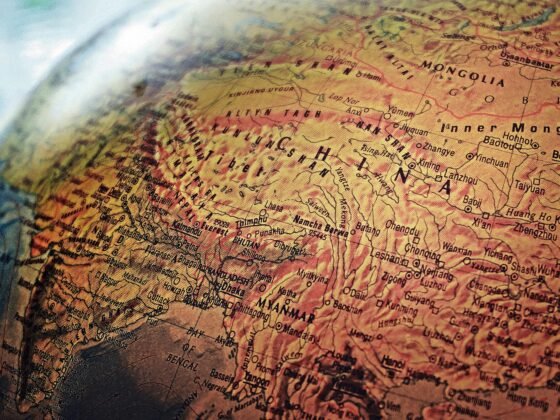As the capital city of China, Beijing is an ancient citadel with a long and rich heritage. Unlike any other city on earth and the antithesis of modern glitzy Shanghai, this city offers cultural wonders in abundance with the Forbidden City, Summer Palace, Tiananmen Square and the Temple of Heaven featuring heavily on the well-worn tourist trail. And with plans to introduce a 72 hour visa-free stay soon, Beijing will be even more appealing.
Tiananmen Square
As the world’s largest public square, Beijing’s Tiananmen Square (Tiananmen Guangchang) is definitely worth a visit, especially because of its history. Named after the Tiananmen Gate (the Gate of Heavenly Peace). Some may remember the name solely because of the infamous massacres in response to the protests there in 1989. The square itself is 99 acres, roughly as big as 90 American football fields. The flag-raising ceremony in the early mornings is interesting to watch. The most important emblems of this square are the four marble lions that stand at the Tiananmen gate, backed by the iconic portrait of Chairman Mao; these together have become familiar to many westerners over the years and are worth seeing, if only for that reason. In the square local vendors peddle cheap souvenirs such as Chairman Mao watches with his arms as the watch hands! Locals also gather here as part of their Chinese New Year celebrations.
The Forbidden City
One of the most popular things to do in Beijing is explore the Forbidden City which was the Chinese Imperial palace from the Ming to Qing Dynasty. Opened in 1420, The Forbidden City today receives more than seven million visitors each year and standing to the north of Tiananmen Square, the Forbidden City is a complex of buildings measuring 7,750,016 square feet which means that it is almost three times the size of Tiananmen Square. As a result, there is a lot to see in the Palace Museum although much of the complex remains closed to tourists. The complex is a maze of halls, pavilions, courtyards and towers. Anyone who wants to get a sense of the scope of Imperial wealth and power during the height of the Qing and Ming dynasties should include the Forbidden City as a part of their China itinerary.
The Summer Palace
The Summer Palace on Kunming Lake was made into a park in 1924 and is considered to be the best of the Imperial Playgrounds. It features gardens, bridges and pavilions in the Qing style as well as the lake itself, which is the perfect location for ice skating in the winter. It is often referred to as the New Summer Palace to distinguish it from the one that was levelled and rebuilt in the years between 1860 and 1903, although this one was initially built in 1750. Almost every part of this UNESCO World Heritage Site is scenic and worthy of being photographed. Stop at the onsite cafe for some Chinese tea and a birdeye view of the beautiful palace.
The Lama Temple
The five halls and five courtyards of the perfectly symmetrical Lama Temple, in the Dongcheng district, comprise what was originally an imperial residence, then a residence for Lamaist monks. Constructed started in 1694 and the site covers some 7 hectares in total. The buildings and relics will be of particular interest to travelers interested in Chinese architecture and artwork, and includes woodcarvings as well as murals done in the Tibetan style.
Peking Opera
Enjoy a performance at the world-renowned Beijing Opera or Peking Opera, as many westerners know it, is really a collection of traditional Chinese art forms. In its present form, it is more than 160 years old and includes artistic genres such as the traditional “Huiban” drama as well as music, literature, martial arts and face-painting. The Cultural Revolution from 1966 to 1976 led to the closing of the opera, but it was once again revived in 1978.
Beihai Park
This imperial park is one of the most iconic parks in the world and dates as far back as 1115 and lies to the northwest of Beijing’s Forbidden City Complex. One of the biggest Chinese gardens at 69 hectares, the park contains numerous temples and palaces. During the Qing dynasty, the park was actually a part of the Forbidden City. It was opened to the public in 1925. There are palaces and gardens in this scenic refuge that will be of interest to those travelers seeking interesting and quintessentially Chinese sights.
The Temple of Heaven
During the Qing and Ming dynasties, this graceful Taoist Temple, also called the Altar of Heaven, was a pilgrimage site for the emperors who would visit it in the hopes of securing good harvests. While large parts of the park’s grounds were appropriated during the Cultural Revolution, what is left is still immense and features such sights of interest as ancient cypress and juniper trees as well as the temple complex itself.
Jingshan Park
The Jingshan Park features a pavilion that emperors would visit to pay their respects to Confucius. Jingshan Park lies across from the Palace Museum’s northern gate and during the Ming and Qing dynasties was used as an imperial garden. It features a five-peaked artificial hill built with the dirt dug up during the excavation of the Forbidden City’s moat.
The Great Wall at Mutianyu
By now most people are aware that the Great Wall is not visible from space and is not a single structure, but still it remains as one of the world’s great historical monuments. The Mutianyu section of the Great Wall lies about 45 miles outside of Beijing in Huairou County. The height of the wall is between 23 and 26 feet and it is almost one and a half miles long, wending its way through wooded mountain areas. Originally intended to protect the capital, much of the Mutianyu wall is constructed with granite and is extremely durable. Both sides of the wall are designed to help defenders fight attacks coming both inside and outside. The wall’s first construction occurred in the Northern Qi Dynasty and was rebuilt almost a thousand years later during the Ming Dynasty.
Pay a visit to Beijing Zoo as well for a glimpse of the naughty giant panda Gu Gu!
Free Things to do in Beijing
Factory 798 otherwise known as the 798 Art Zone is a gathering of painters and sculptors in what was formerly a military base. Visitors may go from gallery to gallery viewing works of art without having to buy anything.
China’s Olympic Park provides free activities for travelers to enjoy in Beijing. The park was built for the 2008 Olympic Games and while much of it has been appropriated for non-Olympic uses, other parts are free to visit and explore. Both the National Aquatic Center and the National Stadium are located here.
Travelers may visit Chairman Mao’s Mausoleum to view the remains of the author of the Cultural Revolution, whose remains are on display there. The mausoleum, also known as the Mao Memorial Hall, is located to the south side of Tiananmen Square.












